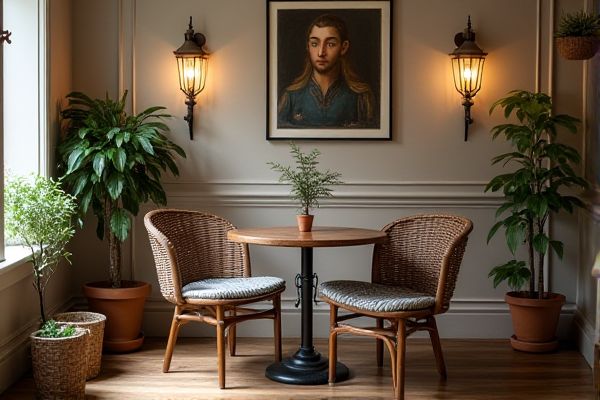
Bistro tables are typically smaller and designed for intimate dining or casual settings, often featuring a round or square top with a height around 28 to 30 inches, while bar tables are taller, usually standing at 40 to 42 inches, making them ideal for standing or high stool seating in social or entertainment spaces. Understanding these differences will help you choose the perfect table style for your space--explore the rest of the article to find out more.
Table of Comparison
| Feature | Bistro Table | Bar Table |
|---|---|---|
| Height | 28-30 inches (standard dining height) | 40-42 inches (taller for standing/bar stools) |
| Usage | Casual dining, small meals, coffee | Bar, high seating, socializing |
| Size | Small, 24-36 inches diameter or square | Varies, often larger for group seating |
| Seating | Standard chairs or stools | Bar stools with footrests |
| Design | Compact, lightweight, often round | Sturdy, taller, often rectangular or round |
| Placement | Kitchens, cafes, small dining areas | Bars, game rooms, counters |
Introduction to Bistro Tables and Bar Tables
Bistro tables, typically smaller and designed for intimate settings, offer a cozy dining experience ideal for cafes or small spaces. Bar tables are taller, providing a casual and social atmosphere often found in pubs, lounges, or entertainment areas. Choosing between a bistro table and a bar table depends on your space requirements and the style of interaction you want to encourage.
Key Differences Between Bistro Tables and Bar Tables
Bistro tables typically feature a smaller diameter ranging from 24 to 36 inches, designed for intimate seating with chairs or stools at standard dining height between 28 and 30 inches. Bar tables are taller, often standing 40 to 42 inches high, accommodating higher stools for casual socializing or standing use. Your choice depends on space, intended use, and seating style, as bistro tables create cozy dining settings while bar tables promote a more relaxed, elevated gathering atmosphere.
Design and Style Comparison
Bistro tables typically feature a compact, round or square top with a stylish, often vintage or Parisian design, making them ideal for intimate dining spaces and casual settings. Bar tables are taller with a sleek, modern aesthetic, designed to complement bar stools and enhance social or entertainment areas. Your choice between a bistro table and a bar table should consider the desired ambiance and functionality, balancing height, design, and room layout.
Ideal Uses and Settings
Bistro tables are ideal for intimate dining settings, such as small cafes, patios, or cozy breakfast nooks, offering a casual and relaxed atmosphere perfect for two to four people. Bar tables are designed for socializing in lively environments including bars, lounges, or event spaces, promoting standing gatherings or high seating arrangements to encourage conversation and easy access to refreshments. Your choice depends on whether you prioritize a laid-back dining experience or a dynamic social interaction.
Height Variations: Bistro vs Bar Tables
Bistro tables typically measure around 28 to 30 inches in height, designed for comfortable dining with standard-height chairs. Bar tables are taller, usually ranging from 40 to 42 inches, meant to be paired with bar stools for elevated seating. Choosing between a bistro table and a bar table depends on the height variation that best suits your space and seating preferences.
Comfort and Seating Options
Bistro tables typically offer lower height and a smaller surface area, making them ideal for intimate seating with standard chairs or stools that promote comfort during casual dining. Bar tables stand taller and are paired with high stools or bar chairs, providing a more social and laid-back seating arrangement but potentially less ergonomic for extended use. Choosing between the two depends on desired comfort levels and the type of seating experience, with bistro tables favoring relaxed dining and bar tables suited for vibrant, standing or perching interactions.
Space Requirements and Functionality
Bistro tables typically require less floor space with smaller diameters around 24-30 inches, making them ideal for intimate dining or cafe settings where space is limited. Bar tables are taller, usually around 40-42 inches, allowing for standing or high seating arrangements that encourage socializing in larger, open areas such as bars or event spaces. Your choice depends on whether you need compact functionality for cozy meals or elevated surfaces for casual, social environments.
Material and Durability Considerations
Bistro tables typically feature materials like wrought iron, wood, or metal with a weather-resistant finish, ensuring durability for both indoor and outdoor use. Bar tables often utilize sturdier materials such as solid wood, chrome, or stainless steel to support heavier weight and frequent use, making them ideal for commercial settings. When selecting your table, consider the material's resilience to wear, moisture, and stability to match your space's functional and aesthetic needs.
Popular Trends in Bistro and Bar Tables
Bistro tables, typically smaller with a cozy design, are trending for their versatility in intimate spaces and casual dining settings. Bar tables, often taller and paired with high stools, remain popular in social and entertainment areas, offering a modern vibe and functionality for standing guests. Choosing your table depends on the atmosphere and space available, with bistro tables favoring relaxed environments and bar tables enhancing lively gatherings.
Choosing the Right Table for Your Space
Bistro tables typically feature a smaller, round top ideal for intimate dining areas or cozy corners, optimizing limited space without sacrificing style. Bar tables are taller with a more expansive surface, suited for casual gatherings in open spaces or home bars, encouraging social interaction while maximizing standing room. Assessing your room's layout and intended use will help you decide whether a bistro table's compact footprint or a bar table's elevated design better complements your space and lifestyle.
 homyna.com
homyna.com